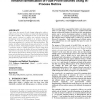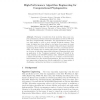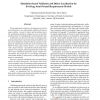329 search results - page 17 / 66 » How accurately can we model timing in a placement engine |
ESEM
2008
ACM
13 years 9 months ago
2008
ACM
Code churn, the amount of code change taking place within a software unit over time, has been correlated with fault-proneness in software systems. We investigate the use of code c...
WWW
2010
ACM
13 years 7 months ago
2010
ACM
Popularity of content in social media is unequally distributed, with some items receiving a disproportionate share of attention from users. Predicting which newly-submitted items ...
ICCS
2001
Springer
13 years 12 months ago
2001
Springer
Abstract. Phylogeny reconstruction from molecular data poses complex optimization problems: almost all optimization models are NP-hard and thus computationally intractable. Yet app...
PTS
2008
13 years 9 months ago
2008
The state space explosion due to concurrency and timing constraints of concurrent real-time systems (CRTS) presents significant challenges to the verification engineers. In this pa...
APSEC
2005
IEEE
14 years 1 months ago
2005
IEEE
When requirements models are developed in an iterative and evolutionary way, requirements validation becomes a major problem. In order to detect and fix problems early, the speci...



